Looking for a few effective methods to keep your plants, bushes and trees safe from deer this fall and winter?
Deer can certainly do a lot of damage during the spring and summer months, but as their food sources begin to dry up late in the year, they often turn their attention even more to the plants growing in your landscape. This can be especially true if you happen to live in an area where the deer population is out of control.
Since there is little in the way of fresh growth in late fall and winter, deer turn their hungry appetites to whatever is left – including chewing the limbs and bark off of trees, or devouring the foliage of small bushes and perennial plants.
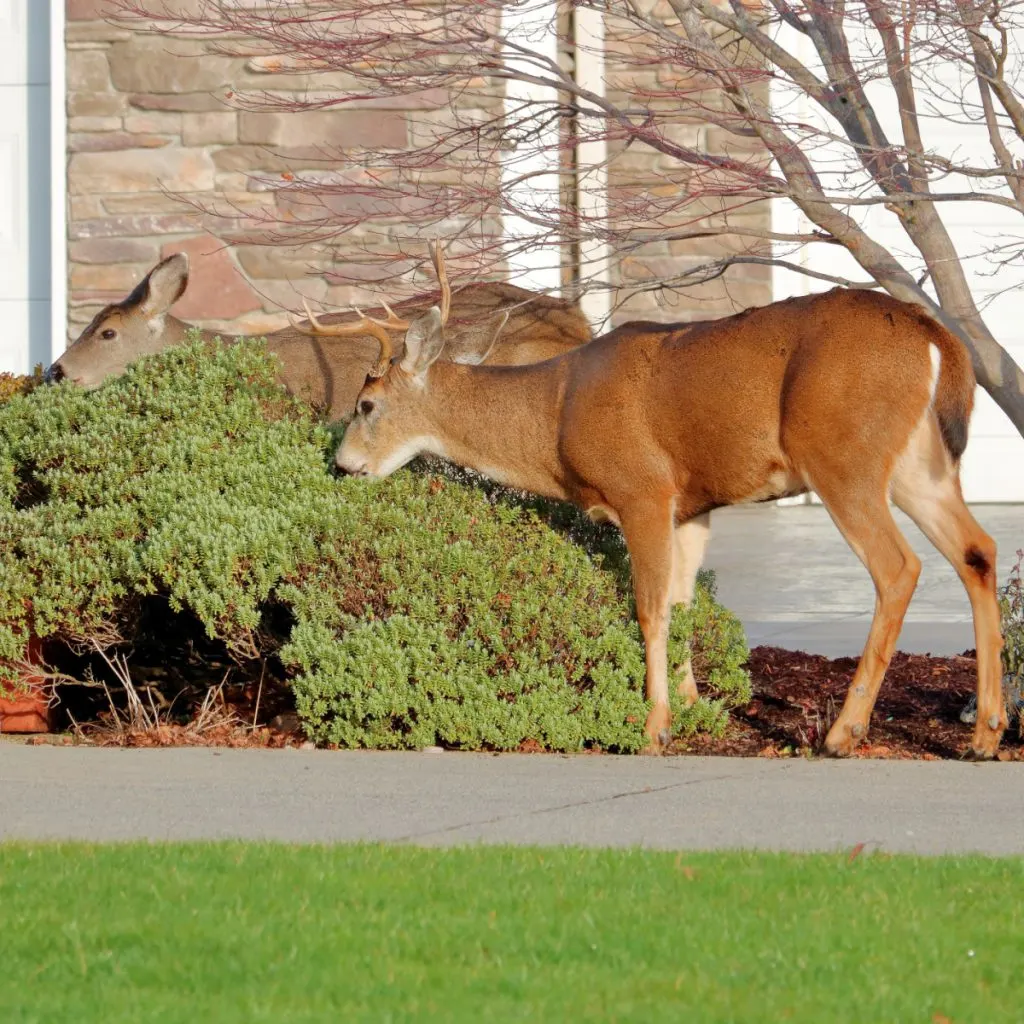
Unfortunately, when it comes to any plant, winter damage can be hard to overcome. In fact, quite often, it can be deadly. When a plant is dormant, it has zero ability to repair damage. And if the winter is severe enough, it can easily freeze or kill the plant off.
But can you really stop deer? Let’s face it, short of installing an 8′ fence around your property, it can seem a daunting task. But the good news is there are a few defensive methods that are quite effective when it comes to eliminating or highly reducing winter deer feeding of plants – and by simply being diligent with these methods through the winter months, you can successfully protect your plants.
How To Keep Plants Safe From Deer In The Fall & Winter – 5 Great Ways To Stop Deer!
More than anything else, the key to success for stopping winter deer damage is to get your defenses in place early. Waiting until winter arrives not only puts your plants at risk of an early attack, but it can also make it extremely difficult for you to work out in the elements.
Before we cover the defensive efforts, it’s important to note that by far, one of the biggest keys to success for preventing deer damage is to always try to plant varieties they simply don’t like.
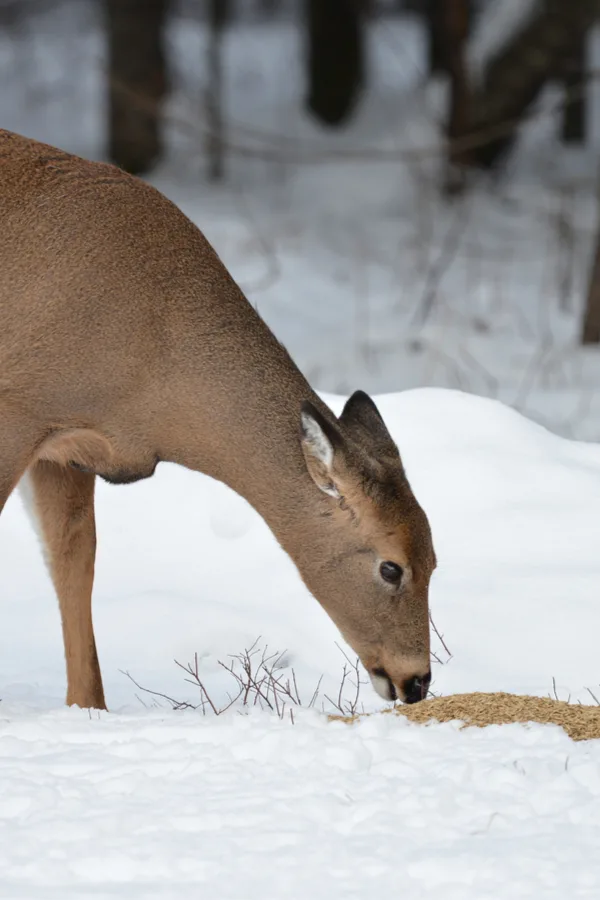
Planting deer-resistant varieties helps not only in the winter, but all year round. Ornamental grass varieties are a great example. Not only will deer ignore them, but they also help to hide plants that deer love in the summer. See: The Best Ornamental Grass Varieties To Plant For Easy Care & Big Interest!
When you do plant deer favorites, plant in areas close to the house, or that are easy to protect with a net or simple deer fence. It will go a long way in keeping deer damage – and your frustration levels down. But with that said – there are some great ways to protect the plants they do love – and one of the best is using a little “hidden” fencing trick using fishing line.
#1 The Fishing Line Trick – How To Keep Plants Safe From Deer In The Fall & Winter
Believe it or not, a few metal posts and fishing line can go a long way in helping prevent damage to flowerbeds. Deer do not like coming in contact with fishing line in the least. Mostly because they can’t see it and don’t like it to touch them.
Start by driving in a few 4′ to 5′ metal or plastic fencing posts to surround your beds or anywhere you want to protect. Be sure to keep them at least a few feet out from the plants. Then, string a few lines of fishing line up – one a the top of the poles, one in the middle and one near the bottom.
The deer will come in contact with the line and not know what it is. And almost without fail, they will not attempt to go through it again to get to the plants. Affiliate Link: Fishing Line Nylon String Cord Clear
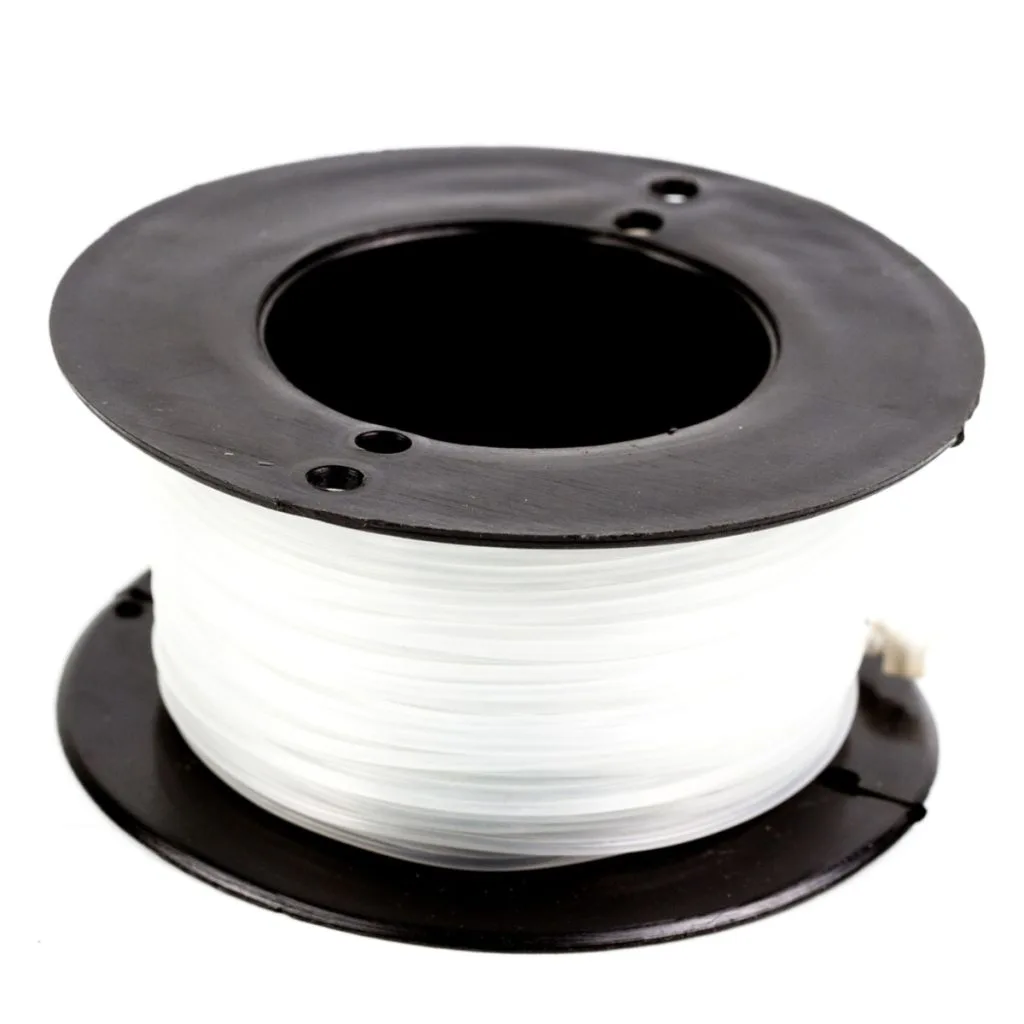
#2 Homemade Egg / Hot Pepper Spray – How To Keep Plants Safe From Deer In The Fall & Winter
Homemade egg spray is another great option for protecting trunks, branches and plant foliage. There are several natural substances that deer tend to avoid, and two of the best just happen to be eggs and hot peppers. When you combine the two, they make a surprisingly good deterrent!
To make the spray, mix six fresh eggs with one gallon of water. Use a blender to completely incorporate the two ingredients together.
In a separate pan, place one cup of freshly blended hot peppers (habanero & cayenne are good options) along with 8 cups of water. When working with hot peppers or any hot pepper spray, always remember to use both goggles and gloves. They can be quite the skin and eye irritant if you don’t protect yourself.
Place on a stove and bring to medium heat. Allow the mixture to simmer for 3 minutes to incorporate into the water. Allow the mixture to then cool. Next, strain the hot peppers away and add the hot pepper infused water to the egg mixture. You now have two gallons of deer repellent spray!
The spray can be applied with a pump sprayer to coat the branches and foliage of plants. Be sure to spray high enough (six to eight feet will work) to keep them from foraging the top of plants. Deer do not like the smell or taste, and it usually will have them moving on after a little nibble.
As with all sprays, remember to re-apply after a rain or snow event to keep an effective barrier on foliage and branches in place.

#3 Using Burlap To Protect Shrubs & Trees – How To Keep Plants Safe From Deer In The Fall & Winter
If you have small trees or shrubs, they are always a prime target for deer! The tender young bark and branches make for an easy snack. Especially for young deer looking for a quick meal. And that is exactly where burlap can save the day!
Burlap is an excellent choice for using to wrap the bark on bushes and trees. Deer love to scrape and chew off the bark, and if the damage is severe enough, it can kill the tree or bush.
Burlap works well because it still allows the plant to breath, but makes getting at the bark or branch impossible for the deer. Unfortunately, plastic mesh covers are often not fine or hard enough to deter the scraping of bark.
In addition, the wispy foliage of evergreen shrubs such as Arborvitaes can still poke through mesh, making it easy for deer to chew at will. But a covering of burlap keeps everything out of sight, and out of a deer’s mouth.
When wrapping with burlap, the secret to success is to take it high enough up the trunk or bush so that deer cannot reach any part of the plant. If they can reach it, they will eat it! Look for large burlap in rolls that can be wrapped or cut to size. Product Link : 15′ Burlap Rolls
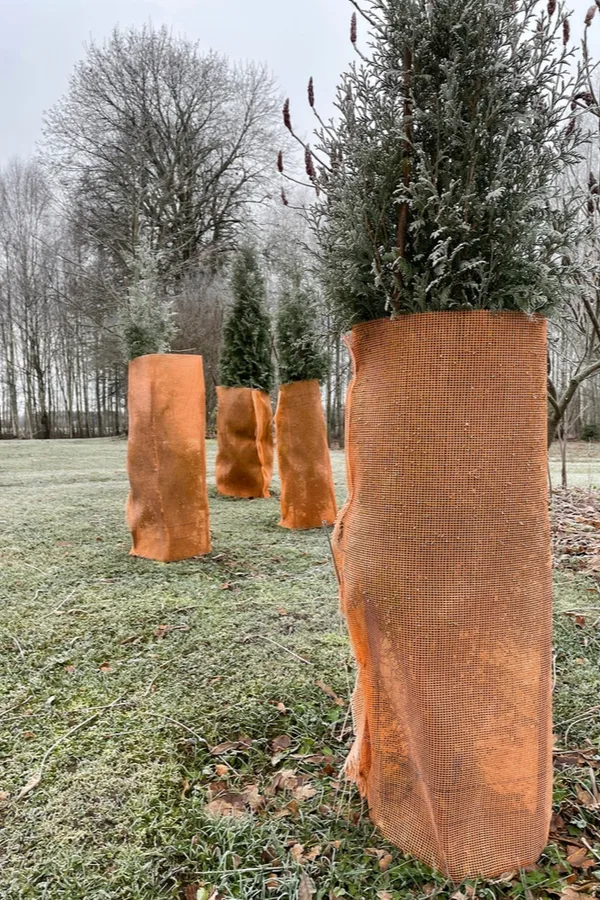
#4 Netting / Wrapping Smaller Plants – How To Keep Plants Safe From Deer In The Fall & Winter
When it comes to protecting perennial plants in flowerbeds from deer, covering them with a fine-mesh netting is the best way to go.
For best results, wrap several layers loosely around each plant. By layering, it makes it nearly impossible for deer to chew through the mesh to reach the plant. At under $20 for 100’ x 7’ roll, netting is one of the most economical solutions around. Product Link : Fine Mesh Netting 100′ Roll
Even better, it is easy to install with simple zip ties and can be re-used year after year. That same mesh netting is also great for using in the summer. It can do wonders to protect vegetable plants and fruit trees from bird and animal damage.
If covering bushes, use a few stakes on either side to support the netting. Wrap the netting loosely around the stakes to make it difficult for deer to reach the plants. For flowerbeds and small shrubs, simply cover the area and zip tie to a small branch. You can also secure with a few small stakes.
#5 Fencing – How To Keep Plants Safe From Deer In The Fall & Winter
If you simply are overrun with deer, fencing may be the only true option to keep from losing your plants. It goes without saying that the most effective deterrent of all for stopping deer is a fence. But it certainly can be costly.
Unfortunately, to provide total protection, a deer fence needs to be tall enough to keep them away from your plants. That type of fencing can often be prohibitively expensive. Especially for large gardens or yards where deer can enter from many directions.
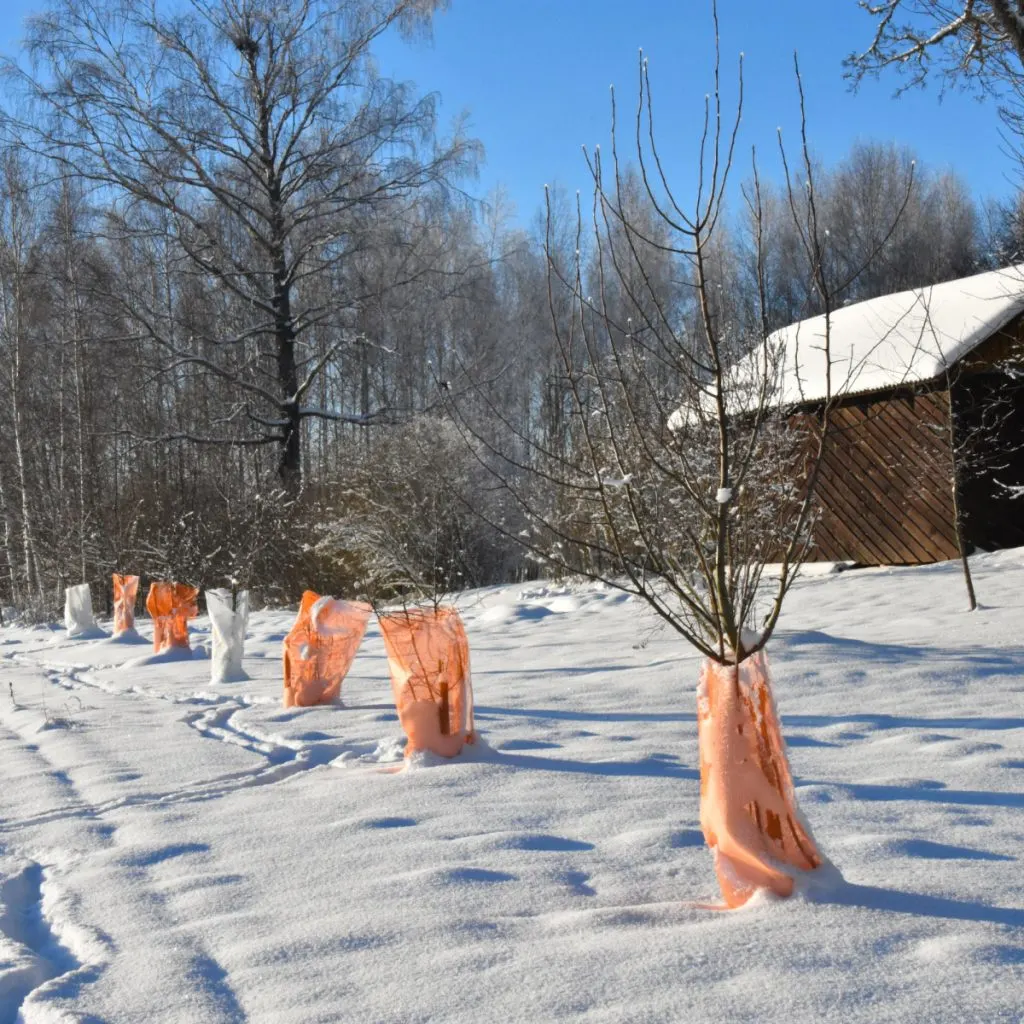
Deer fencing needs to be a minimum of 8’ high for maximum effectiveness. Smaller fencing will keep some deer at bay, but with their ability to jump, the higher the better.
Deer fencing does not have to be permanent. It can be easily installed using large wood or metal stakes and secured with a few zip ties. It can also be re-used from year to year. This can be quite effective and more cost effective for protecting small areas.
For a small vegetable or flower garden area, a simple metal post and wire fence 5 to 6′ tall can be fairly protective. But the key is it has to be a small space. Deer do not like to jump into confined spaces. If the space is compact enough, a smaller fence really will work wonders in protecting plants.
In addition to the steps above, you can simply choose plants that deer won’t eat – see How To Plant Bushes Deer Won’t Eat – The Best Deer Resistant Bushes For Your Yard! Here is to keeping your plants safe from deer this fall and winter!
This Is My Garden
Follow Our Facebook Page For Great Gardening Tips And Advice! This Is My Garden Facebook Page
This Is My Garden is a garden website created by gardeners, for gardeners. Jim and Mary Competti have been writing gardening, DIY and recipe articles and books and speaking for over 15 years from their 46 acre Ohio farm. They publish three articles every week, 52 weeks a year. Sign up today to follow via email, or follow along!
